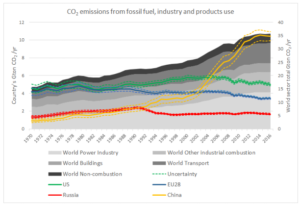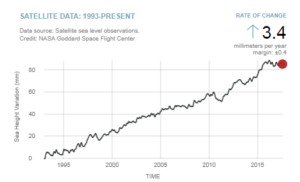by Allan Chatenay, October 21, 2017
Dear Prime Minister Trudeau and Minister McKenna;
Canada has a problem.
Climate Change is Killing Us.
Or more precisely, your view of climate change is killing us.
(…)
by Allan Chatenay, October 21, 2017
Dear Prime Minister Trudeau and Minister McKenna;
Canada has a problem.
Climate Change is Killing Us.
Or more precisely, your view of climate change is killing us.
(…)
by Vijay Jayaraj, October 24, 2017 in WUWT
As a citizen of a third-world country, I bring a different perspective about climate change from that held by most people in wealthy countries. While they fret about possible tenth-of-a-degree changes in global average temperature, I think about how a billion of my fellow Indians and I will obtain the food, water, health care, and other things we need that our richer neighbors take for granted.
See also here
by F. Maccaferri et al., October 23, 2017 in NatureCommunication
Open Article
The results reveal that a lateral collapse can trigger a significant deflection of deep magma pathways in the crust, favouring the formation of a new eruptive centre within the collapse embayment. Our results have implications for the long-term evolution of intraplate volcanic ocean islands.
by Pat Frank, October 23, 2017 in WUWT
Regular readers at Anthony’s Watts Up With That will know that for several years, since July 2013 in fact, I have been trying to publish an analysis of climate model error.
The analysis propagates a lower limit calibration error of climate models through their air temperature projections. Anyone reading here can predict the result. Climate models are utterly unreliable. For a more extended discussion see my prior WUWT post on this topic (thank-you Anthony).
by JoNova, October 18, 2017
The Magnificent Paris deal was rubbery-theatre, make-of-it-what-you-will, and with rare diligence here is Naturepublishing a paper where a team bothered to check progress. (If only Nature held scientific research as accountable as political deals. MBH98 anyone — where Mann’s hockeystick was accepted by Nature, but not the corrections?)
by Patrice Geoffron, 23 octobre 2017 in Le CerclesdesEconmistes, Boursorama
(…) le gaz américain pourrait bouleverser les équilibres mondiaux, avec des conséquences non moins drastiques que pour le pétrole. Les ressources américaines de gaz sont abondantes et, en juillet 2017, le prix interne a atteint son point le plus bas depuis 12 ans, augurant de sa compétitivité à l’export.
by S. Kamal et al., September 30, 2017 in Environment SystemsDecisions
Within this scope, the results reveal a pattern of the climatic effect of desert urbanization with nighttime warming and weaker, but significant daytime cooling. This effect is confined to the urban area and is not sensitive to the size of the city or the detailed land cover types in the surrounding areas. The pattern is identified in both winter and summer.
by Anthony Watts, October17, 2017 in WUWT, Press release
Electricity Consumers Fully Support Scientists’ Letter to EPA Calling for Immediate Reopening of its GHG Endangerment Finding
Key Points: This Letter from over 60 highly credentialed scientists states that: “We the undersigned are individuals who have technical skills and knowledge relevant to climate science and the GHG Endangerment Finding. We each are convinced that the 2009 GHG Endangerment Finding is fundamentally flawed and that an honest, unbiased reconsideration is in order.”
by Anthony Watts, October 20, 2017 in WUWT
The annual assessment of global greenhouse gas (GHG) emissions by the JRC and the Netherlands Environmental Assessment Agency (PBL) confirms that CO2 emissions have stalled for the third year in a row.
The report provides updated results on the continuous monitoring of the three main greenhouse gases: carbon dioxide (CO2), methane (CH4) and nitrous oxide (N2O).
See also here

by MailOnline, January 25, 2016
According to USA Today, one reason for the dramatic rise could be from better reporting and monitoring of the storms.
by Mark Lawson, October, 20, 2017 in ClimateChangeDispatch
Tony Abbott may have annoyed the climate change mob with his speech in London (see Diary), but a far more serious problem for that industry is an admission that global temperatures have not been following climate models.
by P. Gosselin, October 2017 in NoTricksZone
(…) It appears that the much larger changes predicted by other models arise from additional water vapor evaporated into the atmosphere and not from the CO2 itself (…)
(…) Assuming a doubling of CO2 by the late 21st century (assuming no positive water vapor feedback), we should likely expect to see no more than about 0.3-0.5°C global surface warming and certainly not the 2-5°C warming that has been projected by the GCMs [global circulation models (…)
…
by Hermann Harde, March 30, 2017 in Inter.J.Atm.Sciences
Including solar and cloud effects as well as all relevant feedback processes our simulations give an equilibrium climate sensitivity of = 0.7°C (temperature increase at doubled CO2) and a solar sensitivity of = 0.17°C (at 0.1% increase of the total solar irradiance). Then CO2 contributes 40% and the Sun 60% to global warming over the last century.
by Essex C, McKitrick R., Andresen B., June 2006 in J. Non-Eq.Thermodynamics
Physical, mathematical and observational grounds are employed to show that there is no physically meaningful global temperature for the Earth in the context of the issue of global warming. While it is always possible to construct statistics for any given set of local temperature data, an infinite range of such statistics is mathematically permissible if physical principles provide no explicit basis for choosing among them. Distinct and equally valid statistical rules can and do show opposite trends when applied to the results of computations from physical models and real data in the atmosphere. A given temperature field can be interpreted as both “warming” and “cooling” simultaneously, making the concept of warming in the context of the issue of global warming physically ill-posed.
by CERN Courier, November 11, 2017
Future global climate projections have been put on more solid empirical ground, thanks to new measurements of the production rates of atmospheric aerosol particles by CERN’s Cosmics Leaving OUtdoor Droplets (CLOUD) experiment
by T. Edimburgh and J. Day, November 21, 2017, in TheCryopshere
In stark contrast to the sharp decline in Arctic sea ice, there has been a steady increase in ice extent around Antarctica during the last three decades, especially in the Weddell and Ross seas. In general, climate models do not to capture this trend and a lack of information about sea ice coverage in the pre-satellite period limits our ability to quantify the sensitivity of sea ice to climate change and robustly validate climate models
by Benoît Rittaud, 18 octobre 2017, in Contepoints
Le jury pensait, bien sûr, désigner plus tôt le vainqueur de septembre 2017 de la propagande climatique. Il demande pardon aux lecteurs pour avoir à ce point aiguisé leur impatience, mais dispose toutefois d’une circonstance fortement atténuante : à quel irrépressible élan a-t-il fallu faire face !
Quelle fougue des compétiteurs, nouveaux comme anciens, a déferlé ce mois-ci, rendant le choix final tout simplement impossible !
by P. Gosselin, October 17, 2017 in NoTricksZone
from Dr. L. Lüning and Prof. F. Vahrenbolt
Satellite measurements of Antarctic sea ice do not go back even 40 years. That’s not very much, especially when we consider that many natural climate cycles have periods of 60 years and more.
Luckily we have the field of climate reconstruction. Using historical documents and sediment cores, the development of ice cover can be estimated. In November, 2016, Tom Edinburg and Jonathan Day examined shipping log books from the time of Antarctic explorers and published on ice extent in The Cryosphere (…)
by Kenneth Richard, October 16, 2017 in NoTricksZone
A recently highlighted paper published by atmospheric scientists Scafetta et al., (2017) featured a graph (above) documenting post-2000 trends in the published estimates of the Earth’s climate sensitivity to a doubling of CO2 concentrations (from 280 parts per million to 560 ppm).
by Anthony Watts, October 16, 2017
This is interesting. It appears that a “pause” has developed in global sea levels. For two years, since July 2015, there has been no sustained increase in global sea level, in fact, it appears to have actually fallen a bit. This graph, provided by NASA’s Global Climate Change website, tells the story:

by Tony Heller, October 15, 2017 in The Depl.Clim.Sci.Blog
October 15 used to be a warm day in the US, but temperatures have plummeted over the past century.
by Kip Hansen, October 14, 2017 in WUWT
Temperature and Water Level (MSL) are two hot topic measurements being widely bandied about and vast sums of money are being invested in research to determine whether, on a global scale, these physical quantities — Global Average Temperature and Global Mean Sea Level — are changing, and if changing, at what magnitude and at what rate. The Global Averages of these ever-changing, continuous variables are being said to be calculated to extremely precise levels — hundredths of a degree for temperature and millimeters for Global Sea Level — and minute changes on those scales are claimed to be significant and important.
by Uzbek, 29 septembre 2017, in Climato-Réalistes
Dans quelle mesure les émissions anthropiques qui s’élèvent à 9 Giga Tonnes par an (dont 1,5 dues au changement d’utilisation des sols) perturbent le cycle du carbone contribuant à l’augmentation de la concentration de CO2 dans l’atmosphère?
by Connaissance des Energies, 13 octobre 2017
Les émissions américaines de CO2 liées à l’énergie ont baissé de 1,7% en 2016. Elles ont toutefois encore atteint près de 5,2 milliards de tonnes l’an dernier, ce qui fait toujours des États-Unis le 2e émetteur mondial après la Chine.